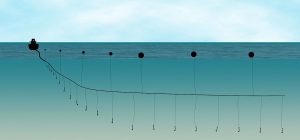Horizontal and vertical movements of white marlin tagged off the Yucatan Peninsula
By Luisa Gil Diaz, SRC Intern
In “Horizontal and vertical movements of white marlin, Kajikia Albida, tagged off the Yucatan Peninsula”, Vaudo et al research the ecology and habitat use of white marlin to improve management measures, particularly within fisheries. White Marlin are a highly migratory and prized sport fish that has recently come under threat. Annually, 10,000 are caught in the United States. However, the highest source of white marlin mortality is when they are bycatch in loglines intended for swordfish and tuna. These billfish are being unintentionally killed off at unacceptable numbers, and while management policies have been implemented, they have focused on quotas and the practice of releasing individuals (Graves and Hordosky, 2015) and have not been very effectual. In fact, “The stock [of white marlin] is currently considered to be overfished with biomass believed to be half of that necessary to achieve maximum sustainable yield” (ICCAT, 2014). Vaudo et al’s study seeks to learn about the way white marlin use their habitat by tagging and tracking them, in order to determine where and how fishing should be allowed.

The white marlin is a prized sports fish of conservational concern.

A longline consists of a long line with many hooks, it does not discriminate between species and can lead to much bycatch.
To conduct the study, 21 white marlins were captured off the eastern Yucatan peninsula between May of 2014 and June 2016. The marlins were brought on board, and a pump was inserted into their mouths to ventilate their gills with salt water (just like we do!). On board, lower jaw fork length measurements were taken, and pop up satellite transmitting tags were inserted onto the dorsal musculature of the white marlin using an umbrella tag. The pop up tags transmitted information about depth, temperature, and light levels once detached from the Marlin after 365 days. Using the information from the tags, temperature-depth profiles were created, indicating the different temperatures present at different depths throughout the marlin’s habitats. Due to technological limitations, involving the satellite tags, there were some gaps in the data, but enough was collected for data analysis.

The Marlin were seen around the Gulf of México, the Caribbean and the northwest Atlantic Ocean (Source: Vaudo et al. 2017).
Using the temperature-depth profiles, analysis on daily temperature profiles the Marlin spent time at were categorized into sets of discrete thermal habitats. The habitats were labeled Habitat A-Habitat G. Maximum daily depth, number of dives, dive length, and dive depth were analyzed at these habitats. Habitat A was the warmest, and the habitat at which the most time (29.5%) was spent daily. It was found that the use of certain waters decreases as cold increases. In fact, 98% of time was spent at waters warmer than 18 degrees Celsius. Temperature also had an effect on the vertical distribution of the swordfish. In warmer waters, dives were deeper and longer. At night, when the water column gets colder, the Marlins stayed within the upper 10 M. These patterns were seen across water columns of different thermal structures across the western Caribbean, the Gulf of Mexico, and the northwest Atlantic. It has been suggested that the reason for this is that the marlins’ are avoiding crossing sharp temperature discontinuities, and that’s why they stay along sub tropical water with a weak thermocline.
This study suggests that the implementation of minimum hook depths for longlines could prevent some Marlin bycatch. It would be an economically feasible strategy that could save. Shorter hooks in the warmer regions were Marlin’s spend more time in deeper water is an easy modification and would be effective in certain areas.
Works Cited
Vaudo, J. J., Byrne, M. E., Wetherbee, B. M., Harvey, G. M., Mendillo, A., & Shivji, M. S. (2017). Horizontal and vertical movements of white marlin, Kajikia albida, tagged off the Yucatán Peninsula. ICES Journal of Marine Science.
ICCAT. 2014. Report for the Biennial Period 2012–13, Part II (2013). International Commission for the Conservation of Atlantic Tunas. Madrid, Spain. 2. 349 pp.
Hoolihan, J. P., Luo, J., Snodgrass, D., Orbesen, E. S., Barse, A. M., and Prince, E. D. 2015. Vertical and horizontal habitat use by white marlin Kajikia albida (Poey, 1860) in the western North Atlantic Ocean. ICES Journal of Marine Science, 72: 2364–2373.
